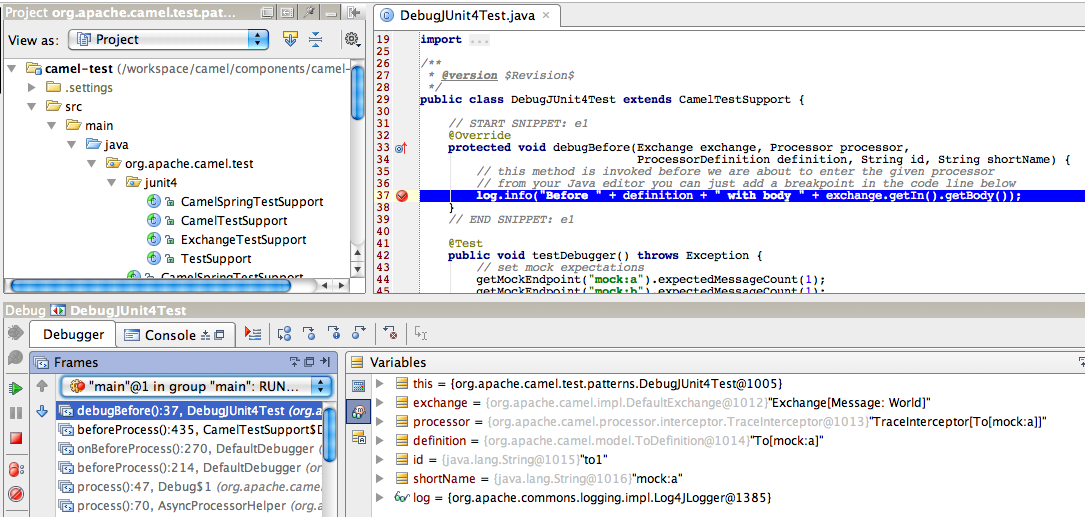Debugger
Since Camel 2.6
Camel Debugger is much related to Tracer, in fact they are sisters. Debugger is a enhanced tracer with a debugger framework so that tooling can be developed to easily monitor Camel routes, trace messages and set breakpoints at points in a route etc.
TIP:There is also a BacklogDebugger which allows to debug from JMX, and 3rd party tooling.
About the Debugger
The Debugger allows tooling or the likes to attach breakpoints which is being invoked when Exchanges is being routed.
Default implementation
Camel provides a default implementation
org.apache.camel.impl.DefaultDebugger which you can set on the
CamelContext using the setDebugger method.
Likewise you can get hold of the Debugger using the
getDebugger method on CamelContext.
The org.apache.camel.spi.Debugger has methods to attach and remove
breakpoints. And to suspend/resume all breakpoints etc.
You can also attach a condition to the breakpoint so it only reacts if
the condition matches.
Easily debugging Camel routes from camel-test
If you are developing unit tests using the camel-test component, then
the Debugger comes out of the box.
From Camel 2.9 onwards you would need to explicit enable the
debugger, by overriding isUseDebugger() method and return true.
Example
In this unit test
public class DebugTest extends CamelTestSupportWe want to debug the following route
@Override
protected RouteBuilder createRouteBuilder() throws Exception {
return new RouteBuilder() {
@Override
public void configure() throws Exception {
// this is the route we want to debug
from("direct:start")
.to("mock:a")
.transform(body().prepend("Hello "))
.to("mock:b");
}
};
}Which can easily done by overriding the debugBefore method as shown
@Override
public boolean isUseDebugger() {
// must enable debugger
return true;
}
@Override
protected void debugBefore(Exchange exchange, Processor processor,
ProcessorDefinition<?> definition, String id, String shortName) {
// this method is invoked before we are about to enter the given processor
// from your Java editor you can just add a breakpoint in the code line below
log.info("Before " + definition + " with body " + exchange.getIn().getBody());
}Then from your Java editor just add a breakpoint inside the
debugBefore method. Then fire up the unit test and wait for the Java
editor to hit the breakpoint. Then you can inspect the
Exchange during debugging while it advances during
routing. The ProcessorDefinition and the id and shortName
parameters is all information which tells you where in the route the
breakpoint was hit.
TIP:There is also a debugAfter method which is invoked after the processor
has been invoked. This allows you to see what happens to the
Exchange right after it has invoked a processor in
the route.
The screenshot below shows the Debugger in action.
The IDE (IDEA) has hit the breakpoint and we can inspect the
parameters.
Notice how we can see that the message is to be send to the "mock:a"
endpoint.

